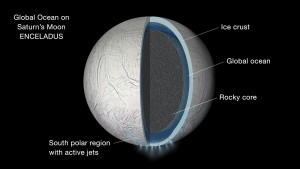New research using data from its Cassini spacecraft shows a global ocean lies beneath the icy crust of Saturn’s moon Enceladus.
NASA’s Cassini mission has confirmed the presence of what it termed a “global ocean” beneath the icy crust of Saturn’s moon, Enceladus and it has managed to deduce the presence of the ocean after analyzing new data from the Cassini mission. This exciting discovery expands the region of habitability for Enceladus from just a regional sea under the South Pole to all of Enceladus.
The global nature of the ocean likely tells us that it has been there for a long time, and is being maintained by robust global effects, which is also encouraging from the standpoint of habitability.
Cassini has previously observed plumes of water, ice and basic organic molecules emerging from fissures near Enceladus’ South Pole, and now by analyzing the moon’s slight wobble, scientists believe its frozen shell does not extend all the way to a rocky interior. They noticed that Enceladus wobbles a bit as it orbits Saturn. This wobble can only be explained by deducing that the moon’s thick icy crust is in fact resting on a liquid surface that causes the moon to wobble a tiny bit as it goes around Saturn.
If the surface and core were rigidly connected, the core would provide so much dead weight that the wobble would be far smaller than what they observed .This proves that there must be a global layer of liquid separating the surface from the core.
Scientists analyzed over seven years’ worth of data and images of Enceladus sent in by Cassini which has been orbiting Saturn since 2004. After carefully analyzing the images, they were in a position to measure minor changes in the moon’s rotation. They figured that the moon rocks back and forth as it goes round Saturn.
Earlier, data from the Cassini mission had observed a fine spray of water vapor, icy particles, and simple organic molecules being emitted from fractures located near the moon’s South Pole. Now, researchers have a clue as to where these materials came from.
On first impression, it seems these materials have their source in this newly discovered global ocean underneath the crust of Enceladus.
Earlier analysis of data from Enceladus suggested the possibility of an underwater sea near the South Pole. However, on further investigation of gravity data received from the moon as Cassini moved around it, it became clear that this sea is global in nature. The new results also provide credence to the presence of a global ocean underneath the surface of Enceladus.
It’s not clear what forces are keeping this ocean warm enough not to freeze, but it is possible that tidal heating from the pull of Saturn’s gravity may be more significant than previously thought.
In the next few months, Cassini is scheduled to make another close flyby of Enceladus on October 28. It is expected to fly just 30 miles above its surface.
For more information please visit: www.nasa.gov

